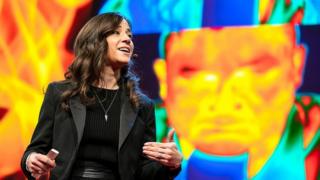INSUBCONTINENT EXCLUSIVE:
Image copyrightBret Hartman/TEDImage caption
Prof Crum believes we should give away more data
The fear
levels of an audience have been measured to show how machines are beginning to reveal people's deepest feelings.The demonstration was part
of a talk given by Dolby Labs chief scientist Poppy Crum at the TED conference in Vancouver.The ability to hide emotions is becoming "a
thing of the past", she said.The professor believes this could usher in an era of empathetic technology."We like to believe we have
cognitive control over what someone else knows, sees, understands about our own internal states - our emotions, insecurities, bluffs or
trials and tribulations," she explained."But technologies can already distinguish a real smile from a fake one."She added that this went far
beyond recording people's actions via a camera or microphone
To demonstrate this, she revealed that the carbon dioxide her audience was exhaling was being monitored."There are tubes in the theatre -
lower to the ground since CO2 is heavier than air," she explained."They're connected to a machine that lets us measure with high precision
the continuous differential concentration of carbon dioxide."Prof Crum then showed a real-time data-visualisation, outlining the changes in
the density of the gas in the room as larger and deeper coloured clouds
"It takes about 20 to 30 seconds for the CO2 from your reactions to reach the machine
You can see where some of us jumped as a deep red cloud
It's our collective suspense creating a spike in CO2," she said.Image copyrightDolby LaboratoriesImage caption
Thermal
signatures give away how people are feeling, said Prof Crum.
In her day job at Dolby Labs, the neurophysiologist has spent
the last few years studying people watch movies.Willing volunteers are hooked up to electroencephalogram (EEG) caps, heart rate monitors,
thermal imaging cameras and skin response sensors in order to observe the biophysical and emotional response that humans experience while
watching videos."The dynamics of our thermal signature give away changes in how hard our brains are working, how engaged or excited we might
be in the conversation we are having, and even whether we're reacting to an image of fire as if it were real," she said."We can actually see
people giving off heat on their cheeks just looking at a picture of flame."In the future Prof Crum thinks that similar tech could improve
people's daily lives.Hearing aids might identify when the wearer is stressed and alter volumes
Personal assistants in the home could pick up on the owner's mood
And sensors could make teachers aware when pupils are struggling to understand a lesson.Speech analysis technologies are already being
developed to provide insights into people's mental and physical health, Prof Crum added
She gave three examples:machine learning can analyse the words people use to predict whether someone is likely to develop psychosisdementia
and diabetes can be revealed by alterations in the "spectral colouration" of a person's voice
The term refers to a way the frequencies and amplitudes of sound can be represented on a graphlinguistic changes associated with Alzheimer's
disease can appear more than 10 years before a clinical diagnosisIn an era when many are considering cutting down their digital footprint,
Prof Crum urged the opposite approach."If we share more data with transparency and effective regulations, it can help create empathetic
technologies that can respond in a more human way that improves our lives," she said

